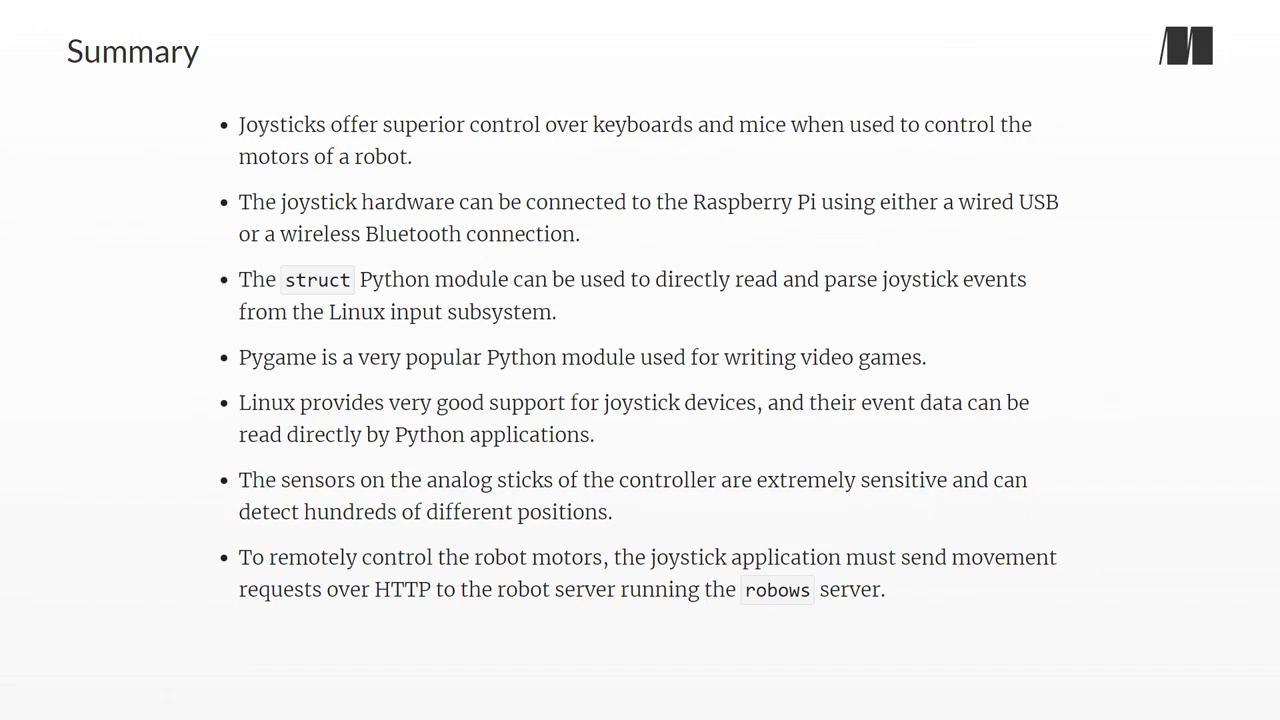Appendix A. Hardware purchasing guide
Appendix A. Motors, chassis kits, and joystick controllers
Appendix A. Optional purchases
Appendix A. Power and cabling
Appendix B. Actiating the Python irtual enironment
Appendix B. Configuring the Raspberry Pi
Appendix B. Setting up the Adafruit CRICKIT HAT
Appendix C. Building a pusher robot
Appendix C. Building a sero camera robot
Appendix C. Creating a track for the pusher robot
Appendix C. Robot assembly guide
Appendix D. Mocking the CRICKIT library
Chapter 1. Our approach to making robots
Chapter 1. Summary
Chapter 1. What are robots made of
Chapter 1. What is a robot
Chapter 2. Changing Neopixel colors
Chapter 2. Checking the touch sensor state
Chapter 2. Configuring the software for our robots
Chapter 2. Controlling DC motors
Chapter 2. Controlling motors with the touch sensor
Chapter 2. Getting started
Chapter 2. Summary
Chapter 3. Controlling the speed and duration of moements
Chapter 3. Driing the robot
Chapter 3. Hardware stack
Chapter 3. Moing backward
Chapter 3. Moing left and spinning in either direction
Chapter 3. Refactoring by finding common logic
Chapter 3. Refactoring by using functools
Chapter 3. Software stack
Chapter 3. Summary
Chapter 3. Turning right
Chapter 3. Using enironment ariables for configuration
Chapter 3. Writing a moe forward function
Chapter 4. Adding a speed argument
Chapter 4. Benefits of a REPL
Chapter 4. Creating a robot shell
Chapter 4. Creating the robot shell
Chapter 4. Handling command arguments
Chapter 4. Hardware stack
Chapter 4. Running robot shell scripts
Chapter 4. Software stack
Chapter 4. Summary
Chapter 5. Calling web serices from Python
Chapter 5. Controlling robots oer SSH
Chapter 5. Controlling robots remotely
Chapter 5. Creating web serices for robots
Chapter 5. Robot testing tips
Chapter 5. Software stack
Chapter 5. Summary
Chapter 6. Creating a full-moement web app
Chapter 6. Creating robot web apps
Chapter 6. Moing robots forward and backward oer the we
Chapter 6. Software stack
Chapter 6. Summary
Chapter 7. Joystick eents
Chapter 7. Joystick-controlled robots
Chapter 7. Measuring the rate of joystick eents
Chapter 7. Moing robots with joysticks
Chapter 7. Reading Linux joystick eents
Chapter 7. Reading joystick eents using Pygame
Chapter 7. Software stac
Chapter 7. Summary
Chapter 8. Capturing images using OpenCV
Chapter 8. Keyboard-controlled camera
Chapter 8. Moing a camera with seros
Chapter 8. Software stack
Chapter 8. Summary
Chapter 9. Creating a face-following robot
Chapter 9. Detecting faces in an image
Chapter 9. Detecting faces in lie ideo
Chapter 9. Face-following camera
Chapter 9. Software stack
Chapter 9. Summary
Chapter 10. Detecting QR codes in an image
Chapter 10. Moing the robot to a target QR code
Chapter 10. Robotic QR code finder
Chapter 10. Software stack
Chapter 10. Streaming lie ideo to multiple applications
Chapter 10. Summary
Chapter 11. Building a snack-pushing robot
Chapter 11. Creating the snack-pushing application
Chapter 11. Finding and pushing snacks
Chapter 11. Software stack
Chapter 11. Summary

